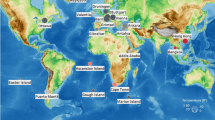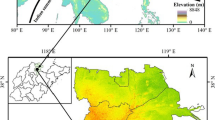Abstract
This two-year study investigates the relative influence of meteorological variables (precipitation amount and temperature), atmospheric circulation, air mass history, and moisture source region on Irish precipitation oxygen isotopes (δ18Op) on event and monthly timescales. Single predictor correlations reveal that on the event scale, 20% of δ18Op variability is attributable to the amount effect and 7% to the temperature effect while on the monthly timescale the North Atlantic Oscillation accounts for up to 20% of δ18Op variability and the amount and temperature effects are not significant. In comparison, multivariate linear regression reveals that the interaction of temperature and precipitation amount explains up to 40% of δ18Op variance at event and monthly timescales. Five-day kinematic back trajectories suggest that the amount-weighted mean δ18Op value of southerly- and northerly-derived events are lower by 2‰ relative to events derived from the west. Because air mass history and atmospheric circulation appear to influence δ18Op in Ireland, Irish paleo-δ18Op proxy records are best interpreted as reflecting a combination of parameters, not just paleotemperature or paleorainfall.







Similar content being viewed by others
References
Baldini LM, McDermott F, Foley A, Baldini JUL (2008) Spatial variability in the European winter precipitation δ18O-NAO relationship: Implications for reconstructing NAO-mode climate variability in the Holocene. Geophys Res Lett 35:L04709. doi:10.1029/2007GL032027
Bolton D (1980) The computation of equivalent potential temperature. Mon Weather Rev 108:1046–1053
Burnett AW, Mullins HT, Patterson WP (2004) Relationship between atmospheric circulation and winter precipitation δ18O in central New York State. Geophys Res Lett 31:L22209. doi:10.1029/2004GL021089
Celle-Jeanton H, Gonfiantini R, Travi Y, Sol B (2004) Oxygen-18 variations of rainwater during precipitation: application of the Rayleigh model to selected rainfalls in Southern France. J Hydrol 289:165–177
Clark ID, Fritz P (1997) Environmental Isotopes in Hydrogeology. CRC Press, Boca Raton
Criss RE (1999) Principles of stable isotope distribution. Oxford University Press, Oxford
Dansgaard W (1964) Stable isotopes in precipitation. Tellus 16:436–468
Diefendorf AF, Patterson WP (2005) Survey of stable isotope values in Irish surface waters. J Paleolimnol 34:257–269
Draxler R R, Rolph G D (2003) HYSPLIT (Hybrid Single-Particle Lagrangian Integrated Trajectory) Model access via NOAA ARL READY Website (http://www.arl.noaa.gov/ready/hysplit4.html). NOAA Air Resources Laboratory, Silver Spring, MD
El-Kadi AK, Smithson PA (1996) An automated classification of pressure patterns over the British Isles. T I Brit Geogr 21:141–156
Epstein S, Mayeda T (1953) Variation of O-18 content of waters from natural sources. Geochim Cosmochim Acta 4:213–224
Fischer MJ, Treble PC (2008) Calibrating climate-δ18O regression models for the interpretation of high-resolution speleothem δ18O time series. J Geophys Res 113:D17103. doi:10.1029/2007JD009694
Gedzelman SD, Arnold R (1994) Modeling the isotopic composition of precipitation. J Geophys Res 99:10455–10471
Gedzelman SD, Lawrence JR (1990) The isotopic composition of precipitation from two extratropical cyclones. Mon Weather Rev 118:495–509
James P, Stohl A, Spichtinger N, Eckhardt S, Forster C (2004) Climatological aspects of the extreme European rainfall of August 2002 and a trajectory method for estimating the associated evaporative source regions. Nat Hazards Earth Syst Sci 4:733–746
Jenkinson AF, Collison FP (1977) An initial climatology of gales over the North Sea. In: (ed) synoptic climatology branch memorandum, Meteorological Office, Bracknell
Jones PD, Hulme M, Briffa KR (1993) A comparison of Lamb circulation types with an objective classification scheme. Int J Clim 13:655–663
Lamb HH (1972) British Isles weather types and a register of the daily sequence of circulation patterns 1861-1971. Geophysical Memoirs 16
Lee J-E, Fung I (2007) “Amount effect” of water isotopes and quatitative analysis of post-condensation processes. Hydrol Process. doi:10.1002/hyp.6637
Lee KS, Grundstein AJ, Wenner DB, Choi MS, Woo NC, Lee DH (2003) Climatic controls on the stable isotopic composition of precipitation in Northeast Asia. Clim Res 23:137–148
McDermott F, Mattey DP, Hawkesworth CJ (2001) Centennial-scale Holocene climate variability revealed by a high-resolution speleothem δ18O record from SW Ireland. Science 294:1328–1331
Morrison J, Brockwell T, Merren T, Fourel F, Phillips AM (2001) On-line high precision stable hydrogen isotope analyses on nanoliter water samples. Anal Chem 73:3570–3575
Noone D, Simmonds I (2002) Associations between d18O of water and climate parameters in a simulation of atmospheric circulation for 1979–95. J Clim 15:3150–3169
Rindsberger M, Jaffe S, Rahamim S, Gat JR (1990) Patterns of the isotopic composition of precipitation in time and space: data from the Israeli storm water collection program. Tellus 42B:263–271
Rozanski K, Araguas-Araguas L, Gonfiantini R (1992) Relation between long-term trends of oxygen-18 isotope composition of precipitation and climate. Science 258:981–985
Rozanski K, Araguas-Araguas L, Gonfiantini R (1993) Isotopic patterns in modern global precipitation. In: Swart PK, Lohmann KC, McKenzie J, Savin S (eds) Climate change in continental isotopic records. American Geophysical Union, Washington, DC, pp 1–36
Sodemann H, Masson-Delmotte V, Schwierz C, Vinther B M, Wernli H (2008a) Interannual variability of Greenland winter precipitation sources, 2: effects of North Atlantic oscillation variability on stable isotopes in precipitation. J Geophys Res 113:D12111. doi:10.1029/2007JD009416
Sodemann H, Schwierz H, Wernli H (2008b) Interannual variability of Greenland winter precipitation sources: Lagrangian moisture diagnostic and North Atlantic oscillation influence. J Geophys Res 113:D03107. doi:10.1029/2007JD008503
Stohl A (1998) Computation, accuracy and applications of trajectories: a review and bibliography. Atmos Environ 32:947–966
Stohl A, James P (2004) A Lagrangian analysis of the atmospheric branch of the global water cycle, part 1: method description, validation, demonstration for the August 2002 flooding in central Europe. J Hydrometeorol 5:656–678
Sweeney J (1985) The changing synoptic origins of Irish precipitation. T I Brit Geogr 10:467–480
Treble PC, Budd WF, Hope PK, Rustomji PK (2005a) Synoptic-scale climate patterns associated with rainfall δ18O in southern Australia. J Hydrol 302:270–282
Treble PC, Chappell J, Gagan MK, McKeegan KD, Harrison TM (2005b) In situ measurement of seasonal δ18O variations and analysis of isotopic trends in a modern speleothem from southwest Australia. Earth Planet Sci Lett 233:17–32
Yapp CJ (1982) A model for the relationship between precipitation D/H ratios and precipitation intensity. J Geophys Res 87:9614–9620
Acknowledgments
The authors gratefully acknowledge the NOAA Air Resources Laboratory (ARL) for the provision of the HYSPLIT transport and dispersion model used in this study. Met Éireann is thanked for their early assistance with back trajectory modeling. The authors are appreciative of Dr Simon Poulson and the UNR isotope laboratory for analyzing our water samples. This manuscript benefited considerably from the thoughtful suggestions of the reviewers and early discussions with Dr Harald Sodemann. The authors are also grateful to Dr Susanna Corti, for her editorial guidance and support throughout the review process. This research was funded by Science Foundation Ireland and a University College Dublin (UCD) Seed Funding grant while LB was a graduate student at UCD.
Author information
Authors and Affiliations
Corresponding author
Electronic supplementary material
Below is the link to the electronic supplementary material.
Rights and permissions
About this article
Cite this article
Baldini, L.M., McDermott, F., Baldini, J.U.L. et al. An investigation of the controls on Irish precipitation δ18O values on monthly and event timescales. Clim Dyn 35, 977–993 (2010). https://doi.org/10.1007/s00382-010-0774-6
Received:
Accepted:
Published:
Issue Date:
DOI: https://doi.org/10.1007/s00382-010-0774-6




